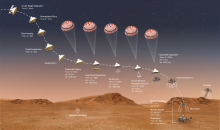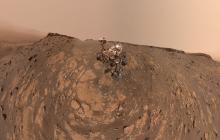Listen to today's episode of StarDate on the web the same day it airs in high-quality streaming audio without any extra ads or announcements. Choose a $8 one-month pass, or listen every day for a year for just $30.
You are here
Moon and Mars
The “hot spots” in the search for life in the solar system are just that — hot spots. They’re places where hot, mineral-rich water bubbles up into seas or oceans. They provide the ingredients for life: water, energy, and the right chemistry. Known as hydrothermal vents, they’re common in Earth’s oceans, and are thought to exist on moons of Jupiter and Saturn.
And a recent study found possible hydrothermal vents on Mars as well — in a giant lake that existed almost four billion years ago.
The lake is in a region known as Eridania. The lake consists of several round basins that probably formed when big space rocks hit Mars. Water then bubbled up from below the ground, filling the basins and some of the surrounding land. The possible lake spans several hundred miles, and the water could have been up to three-quarters of a mile deep. In all, the lake held about nine times as much water as the Great Lakes here on Earth.
Scientists have found possible lakes and seas all across Mars. What makes this one special is that its basins are lined with volcanic rock. It’s likely that at least some of that rock pushed up into the basins when they were filled with water. If so, then the bottom of the lake was dotted with hydrothermal vents. That makes the lake a good place to look for evidence of ancient microscopic life.
And Mars is in great view early tomorrow. It looks like a bright orange star just to the lower right of the Moon at first light.
Script by Damond Benningfield





